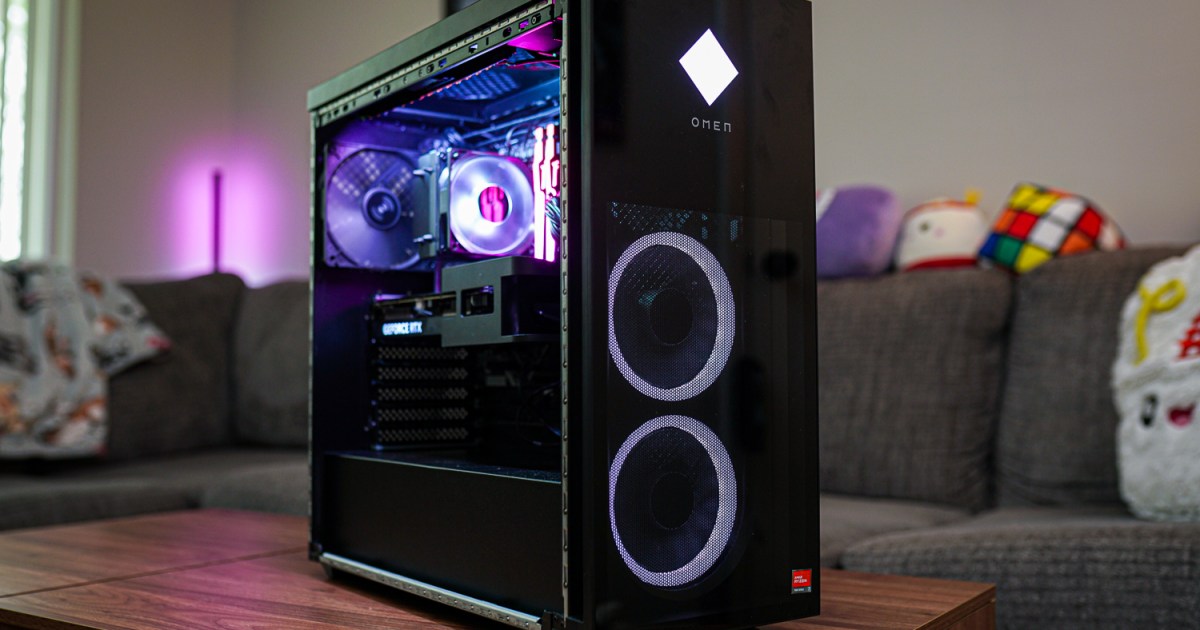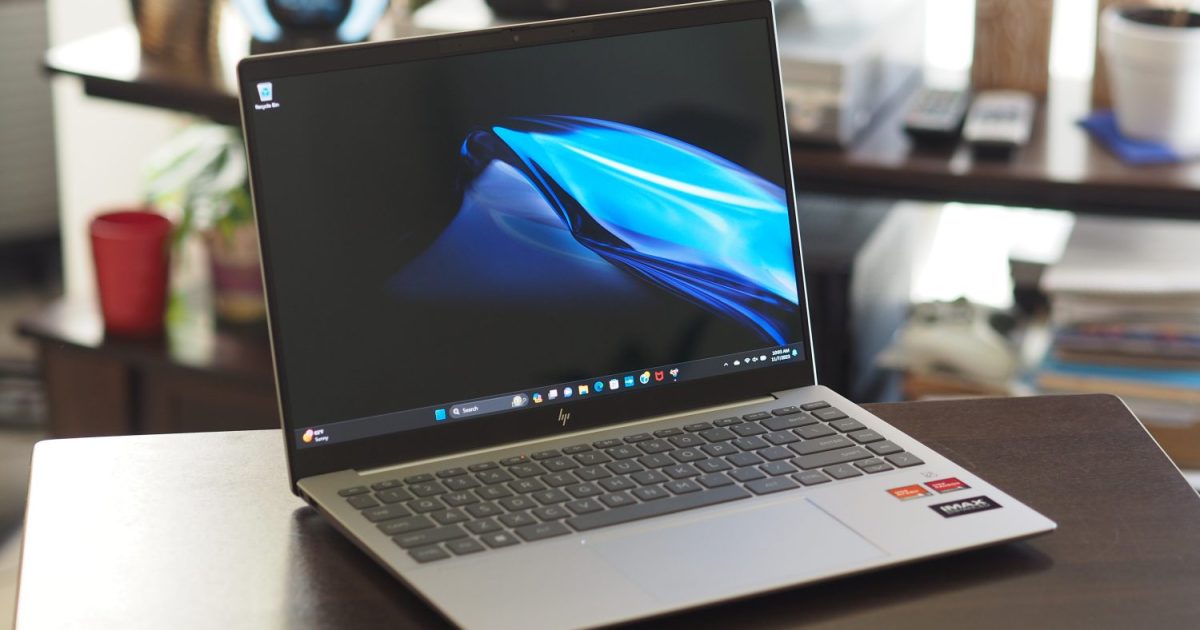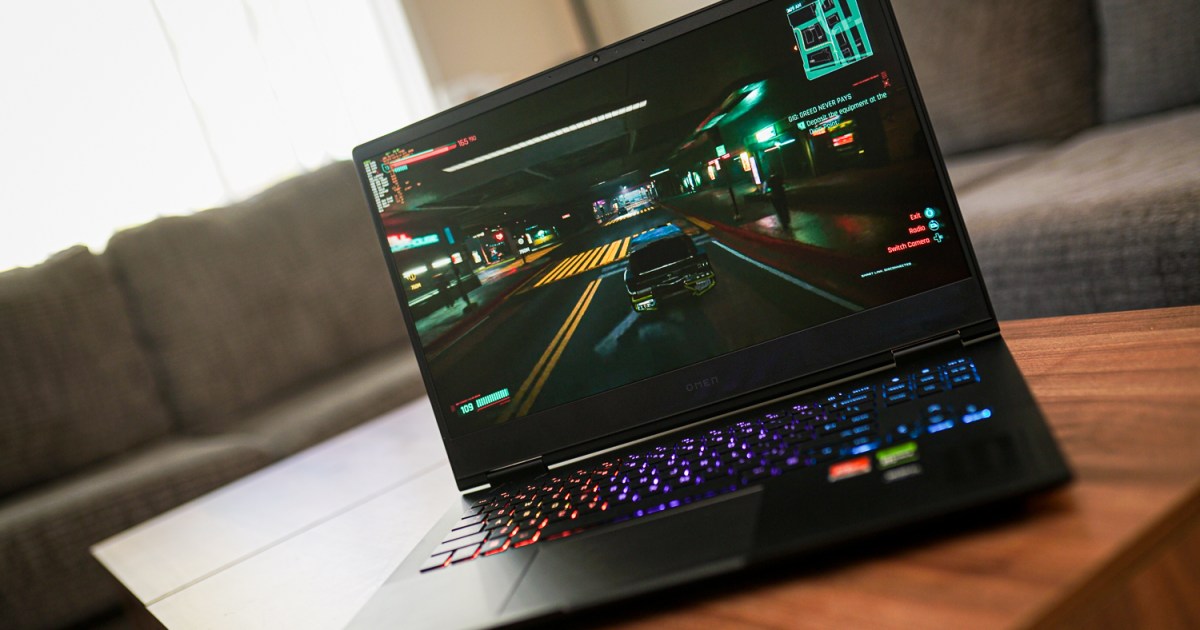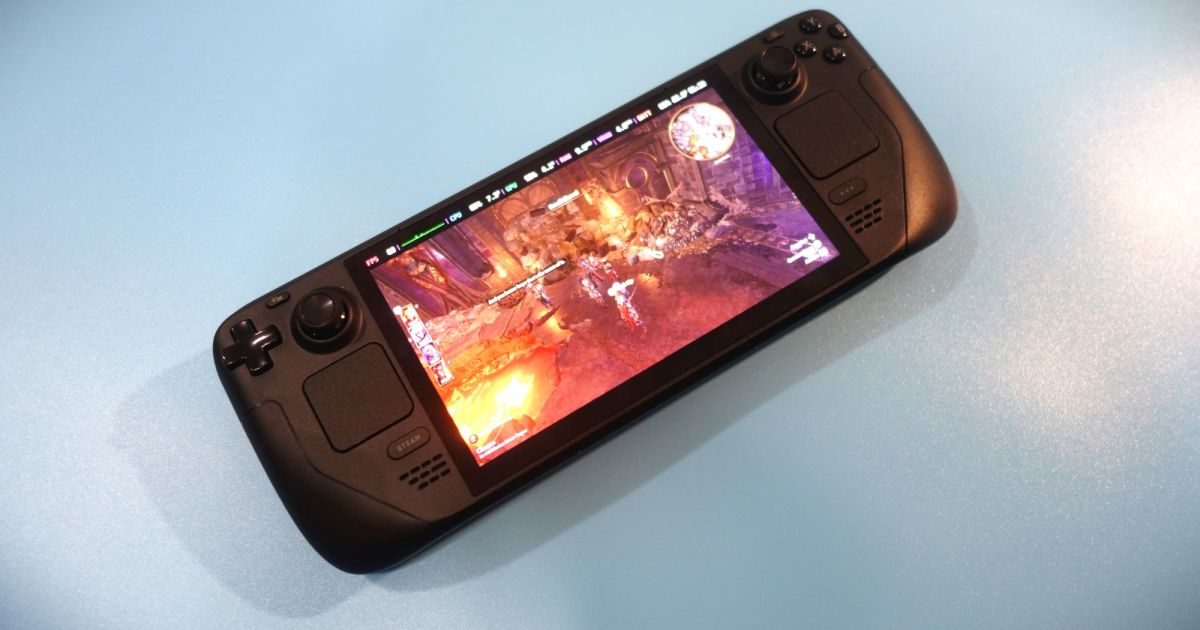The era of foldable and dual-screen laptops being mere novelties is over, and the Asus Zenbook Duo (2024) stands as a testament to this evolution. This innovative machine not only refines previous dual-screen designs but also achieves it at a surprisingly accessible price point. A significant upgrade from its predecessor, the new Zenbook Duo boasts two 14-inch OLED displays and a detachable keyboard, offering unparalleled versatility. While performance inconsistencies were observed between the two configurations tested, it undeniably claims the title of the best dual-screen laptop to date.
Dual-Screen Design and Functionality
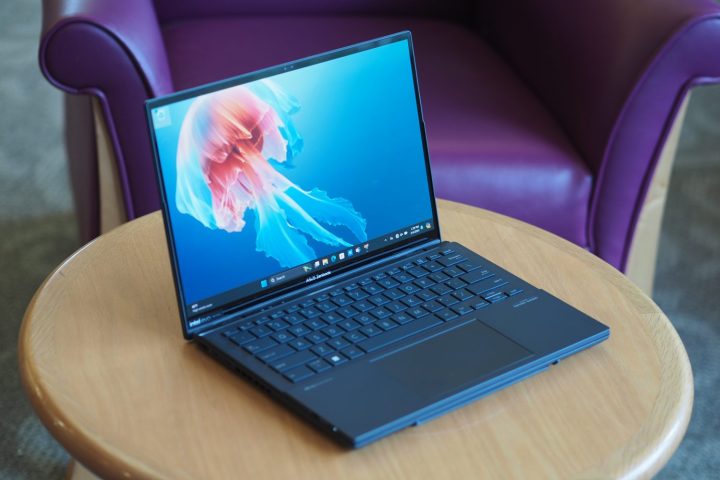 Asus Zenbook DUO 2024 front angled view showing display and keyboard.Image: Asus Zenbook Duo (2024) showcasing its dual-screen design and detachable keyboard.
Asus Zenbook DUO 2024 front angled view showing display and keyboard.Image: Asus Zenbook Duo (2024) showcasing its dual-screen design and detachable keyboard.
The world of dual-screen laptops offers unique advantages compared to foldable counterparts like the HP Spectre Foldable PC and Lenovo ThinkPad X1 Fold. While foldables transform from large tablets into smaller laptops, the Zenbook Duo prioritizes a superior clamshell experience with a physical keyboard integrated into the second display. Its two 14-inch panels provide ample screen real estate for multitasking and creative workflows. Furthermore, the Zenbook Duo adapts to various usage scenarios, functioning as a desktop replacement with displays arranged side-by-side in portrait mode or stacked vertically in landscape mode.
 Asus Zenbook DUO 2024 front view showing dual displays.Image: The Asus Zenbook Duo (2024) with both 14-inch displays visible.
Asus Zenbook DUO 2024 front view showing dual displays.Image: The Asus Zenbook Duo (2024) with both 14-inch displays visible.
Unlike foldable PCs with single, seamless displays, the Zenbook Duo maintains a distinct separation between its screens. This design choice, however, limits its functionality as a traditional tablet, despite both displays supporting active pens for digital drawing and handwriting.
A key differentiator between the Zenbook Duo and its competitor, the Lenovo Yoga Book 9i, is the integrated kickstand. This simple yet effective feature securely props up the Zenbook Duo in both desktop and vertically stacked modes. In contrast, the Yoga Book 9i’s origami stand requires more setup and adds another component to carry. The Zenbook Duo’s design also allows for convenient transport with or without the attached keyboard, unlike the Yoga Book 9i.
 Asus Zenbook DUO 2024 side rear view showing kickstand.Image: The integrated kickstand on the Asus Zenbook Duo (2024).
Asus Zenbook DUO 2024 side rear view showing kickstand.Image: The integrated kickstand on the Asus Zenbook Duo (2024).
Keyboard and Touchpad: A Comfortable Typing Experience
The Zenbook Duo features a full-sized keyboard, a significant advantage over the Yoga Book 9i’s half-sized version. This provides a more comfortable typing experience, complete with large keycaps, ample spacing, and responsive switches. The physical touchpad also outperforms the Yoga Book 9i’s virtual touchpad, eliminating the need for an external mouse in desktop mode.
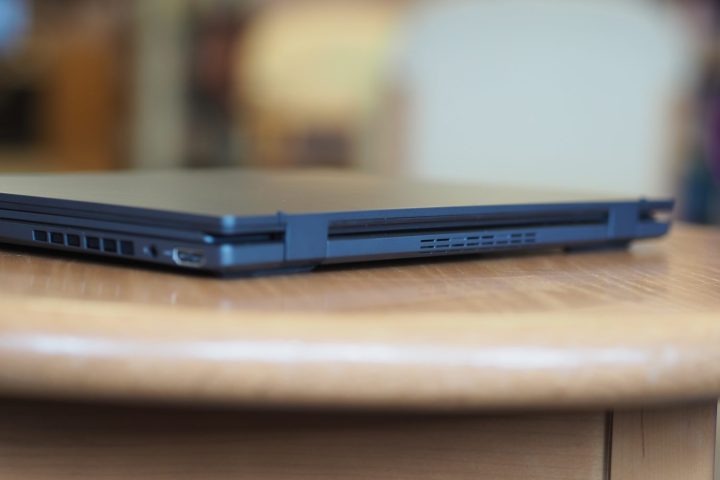 Asus Zenbook DUO 2024 side rear view showing keyboard inserted and vents.Image: The Zenbook Duo (2024) with the keyboard attached and ventilation grilles visible.
Asus Zenbook DUO 2024 side rear view showing keyboard inserted and vents.Image: The Zenbook Duo (2024) with the keyboard attached and ventilation grilles visible.
The keyboard securely attaches via magnets and pogo pins, facilitating charging during use. For external use, it connects via Bluetooth. A software keyboard is also available, activated by a six-finger tap, although its practicality is limited to short text entries. Additional tools on the second screen include a handwriting panel, control panel, and virtual numeric keypad.
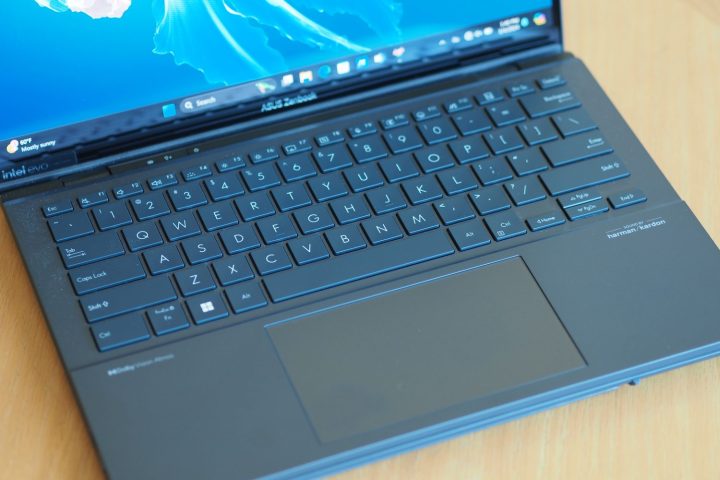 Asus Zenbook DUO 2024 top down view showing keyboard and touchpad.
Asus Zenbook DUO 2024 top down view showing keyboard and touchpad.
Image: Top-down view of the Zenbook Duo’s keyboard and touchpad.
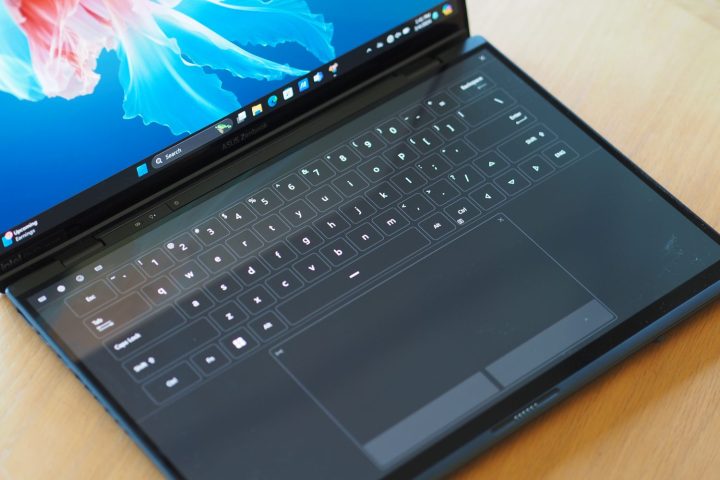 Asus Zenbook DUO 2024 top down view showing software keyboard and touchpad.
Asus Zenbook DUO 2024 top down view showing software keyboard and touchpad.
Image: The software keyboard and touchpad option on the Zenbook Duo (2024).
While the Yoga Book 9i’s Soundbar speaker creates a smoother transition between displays, the Zenbook Duo’s angled design, optimized for clamshell mode, disrupts the horizontal flow in desktop mode. The vertical stacking configuration, easily achieved with the kickstand, proves more ergonomic and visually appealing.
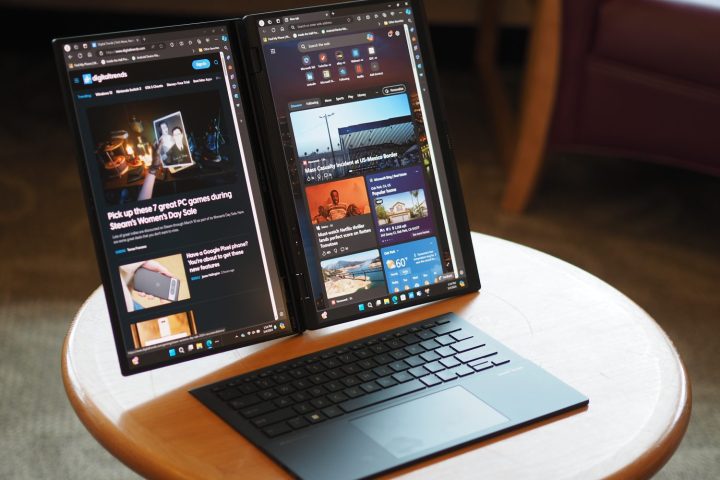 Asus Zenbook DUO 2024 front view showing desktop mode.Image: The Asus Zenbook Duo (2024) in desktop mode.
Asus Zenbook DUO 2024 front view showing desktop mode.Image: The Asus Zenbook Duo (2024) in desktop mode.
Connectivity and Webcam: Modern and Legacy Ports
Unlike other dual-display laptops, the Zenbook Duo offers a comprehensive selection of ports, including modern Thunderbolt 4, legacy USB-A, and HDMI. This versatile connectivity caters to a wide range of peripherals and displays. However, the absence of an SD card reader might disappoint creators. Wireless connectivity utilizes Wi-Fi 6E and Bluetooth 5.2, while some newer laptops have transitioned to Wi-Fi 7. The 1080p webcam delivers serviceable video quality for videoconferencing, supporting Microsoft Studio Effects. Facial recognition is enabled by an infrared camera.
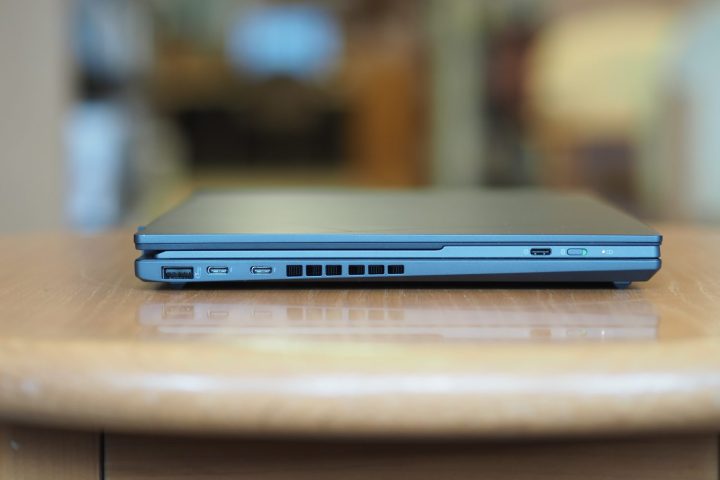 Asus Zenbook DUO 2024 left side view showing ports.
Asus Zenbook DUO 2024 left side view showing ports.
Image: Left side view displaying the available ports.
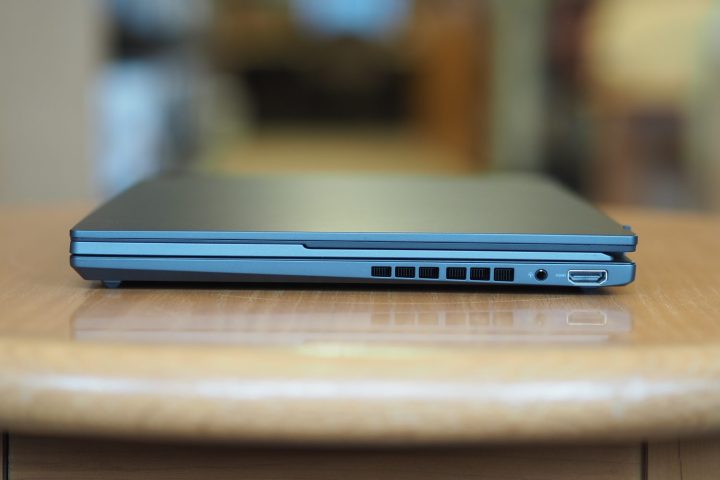 Asus Zenbook DUO 2024 right side view showing ports.
Asus Zenbook DUO 2024 right side view showing ports.
Image: Right side view showcasing additional ports.
Impressive OLED Displays: Vibrant Colors and Deep Blacks
The Zenbook Duo offers a choice between two 14.0-inch 16:10 OLED display options: Full HD+ (1920 x 1200) at 60Hz and 2.8K (2880 x 1800) at 120Hz. Both options deliver vibrant colors and OLED’s signature inky blacks. However, the FHD+ panels exhibit noticeable pixelation in text, making the higher-resolution option preferable for users prioritizing text clarity.
Colorimeter tests reveal excellent display performance across both models. While the FHD+ panels offer slightly better color coverage, the 2.8K panels achieve superior color accuracy. Regardless of resolution, both displays provide exceptional contrast and impressive color performance suitable for various tasks, from productivity to content creation and media consumption. High dynamic range (HDR) content looks stunning, although peak brightness falls short of Mini-LED displays found on Apple’s MacBook Pros.
Performance: Inconsistent Results Across Configurations
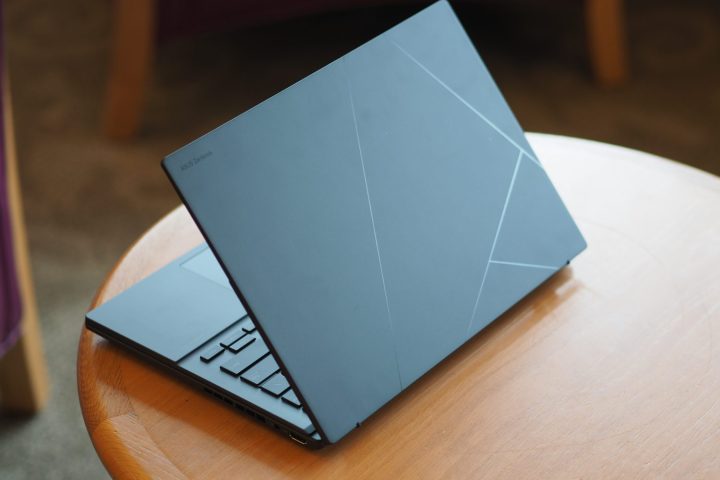 Asus Zenbook DUO 2024 rear view showing lid and pattern.Image: Rear view of the Zenbook Duo, highlighting the lid design.
Asus Zenbook DUO 2024 rear view showing lid and pattern.Image: Rear view of the Zenbook Duo, highlighting the lid design.
The Zenbook Duo configurations tested utilized Intel’s 14th-gen Meteor Lake chipsets. The entry-level configuration features a 28-watt Core Ultra 7 155H, while the higher-end model boasts a 45-watt Core Ultra 9 185H. Benchmark results revealed inconsistent performance between the two. While the Core Ultra 9 demonstrated a marginal improvement in CPU-intensive tasks, its PCMark 10 Complete score was significantly lower, potentially due to thermal throttling.
 Asus Zenbook DUO 2024 side view showing lid and vents.Image: Side view showcasing the lid and ventilation design.
Asus Zenbook DUO 2024 side view showing lid and vents.Image: Side view showcasing the lid and ventilation design.
Surprisingly, the Core Ultra 9’s Intel Arc graphics performed poorly in the 3DMark Time Spy benchmark, scoring similarly to the older Intel Iris Xe graphics. This suggests significant thermal throttling or a potential firmware issue. While neither model experienced excessive heat buildup, the higher-end model’s fans ran more frequently.
Compared to other dual-screen laptops, the Zenbook Duo with the Core Ultra 7 delivers consistently faster performance, especially against foldable PCs. It’s important to note that the Lenovo Yoga Book 9i has recently been updated with Meteor Lake, potentially closing the performance gap. The Zenbook Duo offers sufficient performance for demanding productivity workflows in performance mode. However, its integrated graphics fall short of discrete GPUs, making it unsuitable for creators requiring dedicated graphics power. Gaming performance is also limited.
| Geekbench 5 (single / multi) | Handbrake (seconds) | Cinebench R23 (single / multi) | PCMark 10 Complete | |
|---|---|---|---|---|
| Asus Zenbook Duo (Core Ultra 7 155H) | Bal: 1,743 / 9,340 Perf: 1,730 / 11,230 | Bal: 98 Perf: 82 | Bal: 1,765 / 8,428 Perf: 1,791 / 12,385 | 6,354 |
| Asus Zenbook Duo (Core Ultra 9 185H) | Bal: 1,746 / 9,891 Perf: 1,792 / 11,445 | Bal: 106 Perf: 80 | Bal: 1,799 / 9,364 Perf: 1,818 / 13,228 | 5,621 |
Battery Life: Entry-Level Model Excels
Battery life proved surprisingly good on the Core Ultra 7 model, achieving 8.5 hours in web browsing and 13 hours in video playback with a single display active. With both displays running, battery life decreased by roughly 30 minutes in each test. The Core Ultra 9 model, however, managed only 4.75 hours in web browsing and around 8 hours in video playback with a single display active.
The entry-level model’s battery life is comparable to single-display laptops, even with both screens active, making it a strong performer in this category. The minimal battery life penalty for utilizing both displays is a significant advantage.
Conclusion: A Compelling Dual-Screen Option
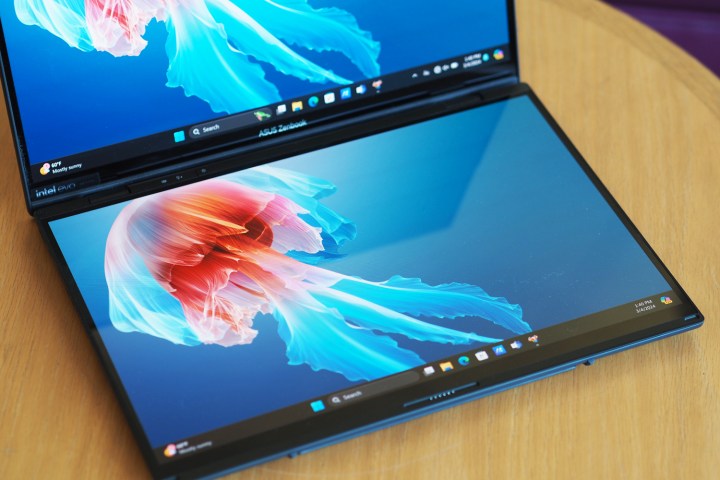 The two screens of the Zenbook Duo.Image: Both displays of the Zenbook Duo in action.
The two screens of the Zenbook Duo.Image: Both displays of the Zenbook Duo in action.
The Asus Zenbook Duo (2024) excels as a well-built dual-screen laptop with compelling features. It surpasses competitors in clamshell and vertically stacked modes, thanks to its integrated kickstand. However, its desktop mode is less impressive.
The entry-level configuration offers superior performance and impressive battery life, making it a strong recommendation and excellent value. The higher-end configuration, while benefiting from higher-resolution displays, doesn’t offer enough advantages to justify its increased cost.




